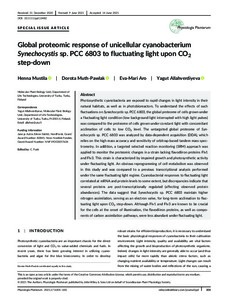Global proteomic response of unicellular cyanobacterium Synechocystis sp. PCC 6803 to fluctuating light upon CO2 step-down
Mustila Henna; Aro Eva-Mari; Allahverdiyeva Yagut; Muth-Pawlak Dorota
https://urn.fi/URN:NBN:fi-fe2021100750385
Tiivistelmä
Photosynthetic cyanobacteria are exposed to rapid changes in light intensity in their natural habitats, as well as in photobioreactors. To understand the effects of such fluctuations on Synechocystis sp. PCC 6803, the global proteome of cells grown under a fluctuating light condition (low background light interrupted with high light pulses) was compared to the proteome of cells grown under constant light with concomitant acclimation of cells to low CO2 level. The untargeted global proteome of Synechocystis sp. PCC 6803 was analyzed by data-dependent acquisition (DDA), which relies on the high mass accuracy and sensitivity of orbitrap-based tandem mass spectrometry. In addition, a targeted selected reaction monitoring (SRM) approach was applied to monitor the proteomic changes in a strain lacking flavodiiron proteins Flv1 and Flv3. This strain is characterized by impaired growth and photosynthetic activity under fluctuating light. An obvious reprogramming of cell metabolism was observed in this study and was compared to a previous transcriptional analysis performed under the same fluctuating light regime. Cyanobacterial responses to fluctuating light correlated at mRNA and protein levels to some extent, but discrepancies indicate that several proteins are post-transcriptionally regulated (affecting observed protein abundances). The data suggest that Synechocystis sp. PCC 6803 maintain higher nitrogen assimilation, serving as an electron valve, for long-term acclimation to fluctuating light upon CO2 step-down. Although Flv1 and Flv3 are known to be crucial for the cells at the onset of illumination, the flavodiiron proteins, as well as components of carbon assimilation pathways, were less abundant under fluctuating light.
Kokoelmat
- Rinnakkaistallenteet [27094]
